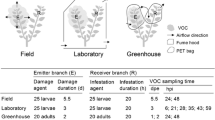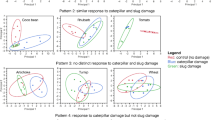Abstract
Volatile organic compounds (VOCs) released from plants are known to mediate indirect defense against herbivores and trigger intra- and interplant signaling. While systemic defense response can be mediated both via volatile and vascular signals, it is not clear whether common ancestry and/or plant growth forms influence the choice of either mode in planta. We hypothesize that larger woody plants with a complex anatomy should rely more on volatile-mediated signaling, apparently to circumvent vascular restrictions that slow down the communication over a large distance. On the other hand, in smaller herbaceous plants faster systemic response can be achieved via vascular signaling. To investigate whether plant VOCs emission is related to plant phylogeny or growth form, we studied the composition of herbivory-induced plant volatiles in 13 Brassicaceae species representing all four evolutionary lineages, because this family is characterized by both a well-resolved phylogeny and highly diverse growth forms. Our results revealed that woody species consistently emitted a more complex blend of volatiles than herbaceous species. However, phylogenetic relatedness of the species did not explain the observed volatile emission patterns. This emphasizes the influence of growth form, rather than phylogenetic relationships on the variation in plant volatile emissions. Our findings suggest that woody, perennial plant species emit diverse VOCs, likely because these compounds comprise a more efficient mode of defense response in these large, anatomically complex plants.


Similar content being viewed by others
References
Abbott HCDS (1886) Certain chemical constituents of plants considered in relation to their morphology and evolution. Bot Gaz 11:270–272. doi:10.1086/326016
Agrawal AA (2007) Macroevolution of plant defense strategies. Trends Ecol Evol 22:103–109. doi:10.1016/j.tree.2006.10.012
Agrawal AA (2011) Current trends in the evolutionary ecology of plant defence. Funct Ecol 25:420–432. doi:10.1111/j.1365-2435.2010.01796.x
Agrawal AA, Weber MG (2015) On the study of plant defence and herbivory using comparative approaches: how important are secondary plant compounds. Ecol Lett 18:985–991. doi:10.1111/ele.12482
Arnold TM, Schultz JC (2002) Induced sink strength as a prerequisite for induced tannin biosynthesis in developing leaves of Populus. Oecologia 130:585–593. doi:10.1007/s00442-001-0839-7
Baldwin IT, Schultz JC (1983) Rapid changes in tree leaf chemistry induced by damage: evidence for communication between plants. Science 221:277–279
Baldwin IT, Halitschke R, Paschold A, von Dahl CC, Preston CA (2006) Volatile signaling in plant-plant interactions: “talking trees” in the genomics era. Science 311:812–815. doi:10.1126/science.1118446
Barton KE, Koricheva J (2010) The ontogeny of plant defense and herbivory: characterizing general patterns using meta-analysis. Amer Naturalist 175:481–493. doi:10.1086/650722
Boege K, Marquis RJ (2005) Facing herbivory as you grow up: the ontogeny of resistance in plants. Trends Ecol Evol 20:441–448. doi:10.1016/j.tree.2005.05.001
Carmona D, Lajeunesse MJ, Johnson MTJ (2011) Plant traits that predict resistance to herbivores. Funct Ecol 25:358–367. doi:10.1111/j.1365-2435.2010.01794.x
Coley PD, Barone JA (1996) Herbivory and plant defenses in tropical forests. Annual Rev Ecol Syst 27:305–335. doi:10.1146/annurev.ecolsys.27.1.305
Dahlgren RMT (1980) A revised system of classification of the angiosperms. Bot J Linn Soc 80:91–124. doi:10.1111/j.1095-8339.1980.tb01661.x
Davis JM, Gordon MP, Smit BA (1991) Assimilate movement dictates remote sites of wound-induced gene expression in poplar leaves. Proc Natl Acad Sci USA 88:2393–2396. doi:10.1073/pnas.88.6.2393
Díaz S, Cabido M (2001) Vive la difference: plant functional diversity matters to ecosystem processes. Trends Ecol Evol 16:646–655. doi:10.1016/S0169-5347(01)02283-2
Díaz S, Kattge J, Cornelissen JHC, Wright IJ, Lavorel S, Dray S, Reu B, Kleyer M, Wirth C, Prentice IC, Garnier E, Bönisch G, Westoby M, Poorter H, Reich PB, Moles AT, Dickie J, Gillison AN, Zanne AE, Chave J, Wright SJ, Sheremet’ev SN, Jactel H, Christopher B, Cerabolini B, Pierce S, Shipley B, Kirkup D, Casanoves F, Joswig JS, Günther A, Falczuk V, Rüger N, Mahecha MD, Gorné LD (2016) The global spectrum of plant form and function. Nature 529:167–171. doi:10.1038/nature16489->
Farmer EE, Gasperini D, Acosta IF (2014) The squeeze cell hypothesis for the activation of jasmonate synthesis in response to wounding. New Phytol 204:282–288. doi:10.1111/nph.12897
Fontana A, Reichelt M, Hempel S, Gershenzon J, Unsicker SB (2009) The effects of arbuscular mycorrhizal fungi on direct and indirect defense metabolites of Plantago lanceolata L. J Chem Ecol 35:833–843. doi:10.1007/s10886-009-9654-0
Franzke A, Lysak MA, Al-Shehbaz IA, Koch MA, Mummenhoff K (2011) Cabbage family affairs: the evolutionary history of Brassicaceae. Trends Pl Sci 16:108–116. doi:10.1016/j.tplants.2010.11.005
Frost CJ, Appel HM, Carlson JE, De Moraes CM, Mescher MC, Schultz JC (2007) Within-plant signalling via volatiles overcomes vascular constraints on systemic signalling and primes responses against herbivores. Ecol Lett 10:490–498. doi:10.1111/j.1461-0248.2007.01043.x
García-Guzmán G, Heil M (2014) Life histories of hosts and pathogens predict patterns in tropical fungal plant diseases. New Phytol 201:1106–1120. doi:10.1111/nph.12562
Gatehouse JA (2002) Plant resistance towards insect herbivores: a dynamic interaction. New Phytol 156:145–169. doi:10.1046/j.1469-8137.2002.00519.x
Heil M (2004) Induction of two indirect defences benefits Lima bean (Phaseolus lunatus, Fabaceae) in nature. J Ecol 92:527–536. doi:10.1111/j.0022-0477.2004.00890.x
Heil M, Adame-Álvarez RM (2010) Short signalling distances make plant communication a soliloquy. Biol Lett 6:843–845. doi:10.1098/rsbl.2010.0440
Heil M, Bueno JCS (2007) Within-plant signaling by volatiles leads to induction and priming of an indirect plant defense in nature. Proc Natl Acad Sci USA 104:5467–5472. doi:10.1073/pnas.0610266104
Heil M, Karban R (2010) Explaining evolution of plant communication by airborne signals. Trends Ecol Evol 25:137–144. doi:10.1016/j.tree.2009.09.010
Heil M, Greiner S, Meimberg H, Krüger R, Noyer JL, Heubl G, Linsenmair KE, Boland W (2004) Evolutionary change from induced to constitutive expression of an indirect plant resistance. Nature 430:205–208. doi:10.1038/nature02703
Howe GA, Jander G (2008) Plant immunity to insect herbivores. Annual Rev Pl Biol 59:41–66. doi:10.1146/annurev.arplant.59.032607.092825
Karban R (2011) The ecology and evolution of induced resistance against herbivores. Funct Ecol 25:339–347. doi:10.1111/j.1365-2435.2010.01789.x
Karban R, Maron J, Felton GW, Eichenseer H (2003) Herbivore damage to sagebrush induces resistance in wild tobacco: evidence for eavesdropping between plants. Oikos 100:325–332. doi:10.1034/j.1600-0706.2003.12075.x
Karban R, Huntzinger M, McCall AC (2004) The specificity of eavesdropping on sagebrush by other plants. Ecology 85:1846–1852. doi:10.1890/03-0593
Kiefer IW, Slusarenko AJ (2003) The pattern of systemic acquired resistance induction within the Arabidopsis rosette in relation to the pattern of translocation. Pl Physiol 132:840–847. doi:10.1104/pp.103.021709
Kigathi RN, Weisser WW, Veit D, Gershenzon J, Unsicker SB (2013) Plants suppress their emission of volatiles when growing with conspecifics. J Chem Ecol 39:537–545. doi:10.1007/s10886-013-0275-2
Mauricio R, Rausher MD, Burdick DS (1997) Variation in the defense strategies of plants: are resistance and tolerance mutually exclusive? Ecology 78:1301–1311. doi:10.1890/0012-9658
Mühlhausen A, Lenser T, Mummenhoff K, Theißen G (2013) Evidence that an evolutionary transition from dehiscent to indehiscent fruits in Lepidium (Brassicaceae) was caused by a change in the control of valve margin identity genes. Pl J 73:824–835. doi:10.1111/tpj.12079
Paradis E, Claude J, Strimmer K (2004) APE: analyses of phylogenetics and evolution in R language. Bioinformatics 20:289–290. doi:10.1093/bioinformatics/btg412
Pérez-Harguindeguy N, Díaz S, Garnier E, Lavorel S, Poorter H, Jaureguiberry P, Bret-Harte MS, Cornwelf WK, Craine JM, Gurvich DE, Urcelay C, Veneklaas EJ, Reich PB, Poorter L, Wright IJ, Ray P, Enrico L, Pausas JG, de Vos AC, Buchmann N, Funes G, Quétier F, Hodgson JG, Thompson K, Morgan HD, ter Steege H, van der Heijden MGA, Sack L, Blonder B, Poschlod P, Vaieretti MV, Conti G, Staver AC, Aquino S, Cornelissen JHC (2013) New handbook for standardized measurement of plant functional traits worldwide. Austral J Bot 61:167–234. doi:10.1071/BT12225
Pichersky E, Lewinsohn E (2011) Convergent evolution in plant specialized metabolism. Annual Rev Pl Biol 62:549–566. doi:10.1146/annurev-arplant-042110-103814
Rønsted N, Symonds MR, Birkholm T, Christensen SB, Meerow AW, Molander M, Mølgaard P, Petersen G, Rasmussen N, van Staden J, Stafford GI, Jäger AK (2012) Can phylogeny predict chemical diversity and potential medicinal activity of plants? A case study of Amaryllidaceae. BMC Evol Biol 12:182. doi:10.1186/1471-2148-12-182
Saitou N, Nei M (1987) The neighbor-joining method: a new method for reconstructing phylogenetic trees. Molec Biol Evol 4:406–425. doi:10.1093/oxfordjournals.molbev.a040454
Scanion JT, Willis DE (1985) Calculation of flame ionization detector relative response factors using the effective carbon number concept. J Chromatogr Sci 23:333–340. doi:10.1093/chromsci/23.8.333
Schittko U, Baldwin IT (2003) Constraints to herbivore-induced systemic responses: bidirectional signaling along orthostichies in Nicotiana attenuata. J Chem Ecol 29:763–770. doi:10.1023/A:1022833022672
Schuman MC, Baldwin IT (2016) The layers of plant responses to insect herbivores. Annual Rev Entomol 61:373–394. doi:10.1146/annurev-ento-010715-023851
Schuman MC, Heinzel N, Gaquerel E, Svatos A, Baldwin IT (2009) Polymorphism in jasmonate signaling partially accounts for the variety of volatiles produced by Nicotiana attenuata plants in a native population. New Phytol 183:1134–1148. doi:10.1111/j.1469-8137.2009.02894.x
Unsicker SB, Kunert G, Gershenzon J (2009) Protective perfumes: the role of vegetative volatiles in plant defense against herbivores. Curr Opin Pl Biol 12:479–485. doi:10.1016/j.pbi.2009.04.001
Van Dam NM, Horn M, Mareš M, Baldwin IT (2001) Ontogeny constrains systemic protease inhibitor response in Nicotiana attenuata. J Chem Ecol 27:547–568. doi:10.1023/A:1010341022761
Van de Peer Y (2009) Phylogenetic inference based on distance methods. In: Lemey P, Salemi M, Vandamme A-M (eds) The Phylogenetic Handbook, 2nd edn. Cambridge University Press, Cambridge, pp 142–160
Violle C, Navas ML, Vile D, Kazakou E, Fortunel C, Hummel I, Garnier E (2007) Let the concept of trait be functional! Oikos 116:882–892. doi:10.1111/j.2007.0030-1299.15559.x
Watson MA, Casper BB (1984) Morphogenetic constraints on patterns of carbon distribution in plants. Annual Rev Ecol Syst 15:233–258. doi:10.1146/annurev.es.15.110184.001313
Wink M (2003) Evolution of secondary metabolites from an ecological and molecular phylogenetic perspective. Phytochemistry 64:3–19. doi:10.1016/S0031-9422(03)00300-5
Wu J, Baldwin IT (2010) New insights into plant responses to the attack from insect herbivores. Annual Rev Genet 44:1–24. doi:10.1146/annurev-genet-102209-163500
Acknowledgements
We thank Michael Reichelt and Tobias Köllner for their assistance with chemical analysis, the Botanical Garden Osnabrück and Barbara Neuffer for providing plant material, Andreas Mühlhausen for advice on statistical analyses, Martin Heil for stimulating discussion and comments on an earlier version of the manuscript, and two anonymous reviewers for their comments on the manuscript.
Author information
Authors and Affiliations
Corresponding author
Ethics declarations
Conflict of interest
The authors declare that they have no conflict of interest.
Additional information
Handling editor: Marcus Koch.
Electronic Supplementary Material
Below is the link to the electronic supplementary material.
Information on Electronic Supplementary Material
Information on Electronic Supplementary Material
Online Resource 1. Quantity of detected volatile organic compounds (VOCs) emitted from 13 species representing herbaceous and woody growth forms and Brassicaceae main lineages Aethionemeae, lineage I – III.
Rights and permissions
About this article
Cite this article
Schrader, J., Unsicker, S.B., Bhattacharya, S. et al. Growth form rather than phylogenetic relationship predicts broad volatile emission patterns in the Brassicaceae. Plant Syst Evol 303, 653–662 (2017). https://doi.org/10.1007/s00606-017-1397-8
Received:
Accepted:
Published:
Issue Date:
DOI: https://doi.org/10.1007/s00606-017-1397-8




